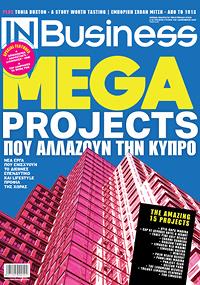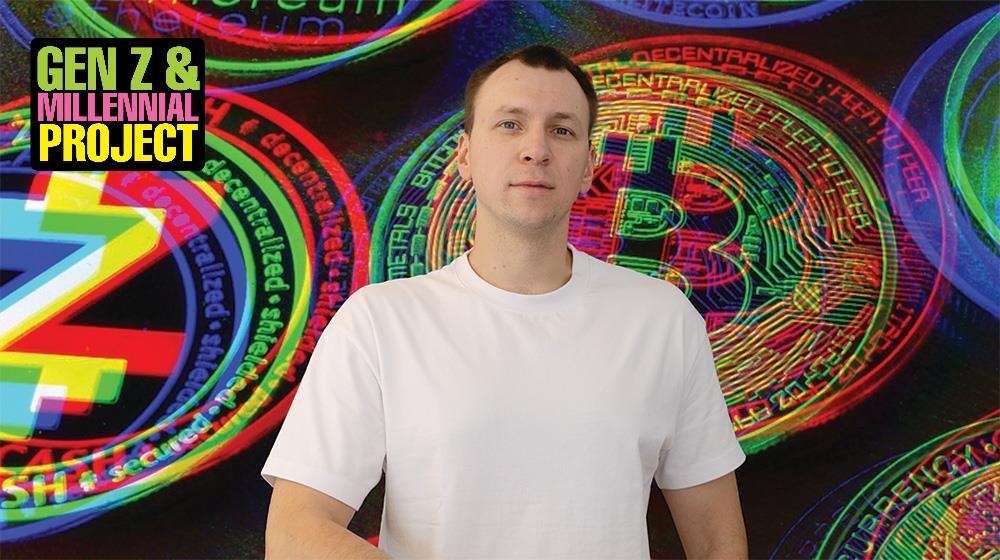Hot off its inclusion in the world’s top 300 fintech companies by CNBC and Statista, Finery Markets has its sights set on becoming the leading institutional crypto marketplace. GOLD magazine spoke with its co-founder and CEO, Konstantin Shulga, about where crypto markets are headed, the rise of stablecoins and Finery Markets’ role in it all.
About forty minutes into our conversation – we had taken shelter from the punishing August heat in the manufactured cool of Milkbar, Limassol – Konstantin Shulga dropped a head-turning revelation. Leaning forward in his chair, the co-founder and CEO of Finery Markets said, “I want us to be the AWS (Amazon Web Services) of matching engines.”
Building a marketplace
Since 2019, Shulga and his team have been building Finery Markets as a crypto marketplace tailored to institutions. On one side, investment banks, hedge funds, payment companies, brokers and any institutional player looking for access to crypto. On the other, the liquidity providers, the market makers that provide pricing and depth. It's a technically and commercially demanding business to build, especially when convincing liquidity providers to come onboard. “It took blood, sweat and tears,” he said, without wishing to elaborate. This year, Finery Markets earned a spot on CNBC and Statista’s list of the world’s top 300 fintech companies – those tears were evidently worth shedding.
Shulga spent almost two decades in capital markets, first on the institutional side with UniCredit, then in electronic trading across asset classes and later running SberBank CIB’s brokerage arm. He had a vantage point that few others did and, when he went looking for his next challenge, he knew it had to be global. Crypto, in that regard, was irresistible. The idea behind Finery Markets was simple: crypto would evolve in the image of traditional markets, growing up from its chaotic adolescence. Custody, clearing, brokerage and market-making would be separated, just as they are in mature classes. “When we started in 2019, there was nothing like us,” he recalled. “Centralised exchanges acted as brokers, custodians and, sometimes, even market makers.” It was the Wild West, with firms playing the roles of vault, referee and shopkeeper all at once – conflicts of interest abounded and even the most hardened risk manager would have broken a sweat. “This was not an institutional-grade setup,” he noted.
Tackling fragmentation
In 2025, the cryptocurrency market remains highly fragmented, arguably more so than traditional markets like foreign exchange. Trading happens across a host of exchanges, each with its own liquidity pools, order books, prices and underlying technology. This naturally brings inconsistencies, like the same cryptocurrency having different prices on different exchanges, time lags in placing trades and varying degrees of reliability. Back in Milkbar, Shulga put it simply, “Whenever you have fragmentation, an ECN just helps consolidate that.” An ECN – Electronic Communication Network – is essentially what capital markets call an online marketplace. “With an ECN,” he explained, “you now have an aggregated order book, where there are multiple market makers providing pricing and the client just gets the best execution in finding liquidity.” In this, Finery’s matching engine is key: a system that maintains a real-time record of all open buy and sell orders and automatically pairs them. “This is very important,” he said. “When they aggregate, most solutions in the space basically integrate into different external API and connectivity layers. If one is built poorly, the entire setup falls apart.” So, Finery Markets is built to connect institutional investors with liquidity providers – and, Shulga emphasised, with all types of liquidity – while avoiding the pitfalls of a scattered market. Everyone plays by the same rules. “If a client is executed against five different market makers, the quality will be the same,” he said. “They’ll know that whenever they trade, they’re getting the best price, no external dependencies, no latency, no slippage.”
The mechanical whirl of the coffee machine, building up steam, briefly drowned out our conversation. A new wave of customers filtered into the shop. Just a few miles northwest, the largest fire that Cyprus had seen in fifty years was devouring communities and acres of land, the sky above Limassol choked with a melancholy grey. “Could you see the fires?” was the first thing Shulga said. In the aftermath, Finery Markets joined more than 50 local tech companies in raising funds to support the affected communities. As the noise in the café subsided, Shulga turned to the challenges of building a marketplace, mainly the classic chicken-and-egg dilemma: who comes first, the investors or the providers? Early on, even institutional investors were hesitant. “There were lots of discussions where they challenged us, like how can we trade through you and get better execution, versus just integrating directly with a couple of market makers,” he explained. But as people from traditional finance – who understood the risks of commingled services – began entering the crypto space, that hesitation began to fade. Today, Finery Markets works with 18 liquidity providers and a network of 150 clients across 35 countries. “If you truly believe you’ve built something unique and great,” Shulga said, “you just need to spread the word. It will take time, but the clients will eventually understand.”
The stablecoin revolution
Stablecoins are arguably the most exciting development in today’s crypto market. They run on blockchain infrastructure and are typically backed by cash or government bonds. Unlike Bitcoin, their price barely fluctuates. The largest stablecoin, Tether – issued by the eponymous company – is designed to maintain a flat value of one US dollar. While stablecoins are primarily used to trade other cryptocurrencies, they’re beginning to find real-world applications as well. At Finery Markets, for instance, around 40% of the company’s 45 employees are paid in stablecoins. “It’s just extremely efficient,” Shulga noted. “We don’t need to open local bank accounts or pay huge FX conversion fees.”
In 2025, Walmart, Amazon and Expedia Group begun exploring ways to issue or use stablecoins, potentially saving billions in fees typically paid to move money the traditional way. The US has been leading the charge. This year, it enacted the chunkily titled Guiding and Establishing National Innovation for US Stablecoins Act (GENIUS Act) marking the first federal regulatory framework for payment in stablecoins. Over 99% of the global stablecoin market capitalisation is dollar-denominated, with the total value of USD-pegged stablecoins exceeding US$230 billion. According to a16zcrypto, the crypto arm of Andreessen Horowitz – the world’s largest VC firm by assets – roughly US$33 trillion in transaction volume has run on blockchain rails in the past 12 months. That’s nearly 20 times PayPal’s volume and close to three times Visa’s. Shulga is convinced that this is a defining moment for the dollar. “Everyone can now freely use dollars in the digital world and everything in the digital world is priced in US dollars. You don’t know the price of Bitcoin in euros, do you?”
So what does that mean for the euro? Does it risk being weakened?
“Yes,” he said. “USD-pegged stablecoins acting as a digital extension of the US dollar pose a risk for any alternative means of payment, including the euro. While these stablecoins don't create a monetary multiple like traditional fiat, their widespread adoption amplifies the dollar's utility in the digital economy, especially for cross-border transactions.” If euro-based stablecoins fail to gain traction, he warned, the euro risks losing momentum and influence. “This could lead to a further shift in international digital payment rails toward USD, subtly eroding the euro’s global utility.” Regaining market share at a later stage would prove challenging. Shulga is also confident that stablecoins would fragment in much the same way other digital assets have – there are already more than ten major stablecoins trading across multiple blockchains. Finery Markets, he explained, plans to become the secondary market for price discovery and transactions between them. “So you can freely convert one stablecoin to another, or from a stablecoin to fiat. We’re building that network,” he said.
The EU is taking a more cautious, state-centred approach. European Central Bank President Christine Lagarde has described stablecoins as a threat that could lead to “a privatisation of money,” ultimately undermining central banks’ ability to conduct effective monetary policy. So, the ECB is developing its own digital euro as a public-sector alternative to stablecoins and other private payment mechanisms. Under the recently adopted Markets in Crypto-Assets (MiCA) regulation, stablecoin issuers face a regulatory regime that mirrors that of banks, including capital and operational requirements. As part of these rules, issuers must hold reserve assets exclusively with licensed banks based in the European Economic Area. That creates a problem for anyone dealing with banks in Cyprus, which notoriously won’t allow even a byte of crypto to run through their accounts. Nonetheless, Shulga is not convinced that MiCA gets the balance right. “It’s a protective measure to facilitate only local European stablecoins. Cutting out the largest stablecoin issuers just doesn’t make sense,” he said. “But we’ll see how it goes; maybe there will be changes.”
Cyprus and the road ahead
When deciding where to base Finery Markets, Shulga and his co-founders put together a spreadsheet comparing 20 cities, including Limassol, New York and London. In the end, Cyprus’ second largest city won out thanks to its sunshine, favourable tax regime and widespread use of English. The ability to attract international talent was also key, especially since relying solely on the local market – which includes both current and prospective clients – would have been ill-advised. Shulga was enthusiastic about the country’s broader potential. “Over the last five to ten years, Cyprus has created one of the best ecosystems for attracting talent,” he said.
While Finery Markets began as a pure B2B marketplace, three years ago it developed a B2B2B product: a white-label infrastructure that allows banks, brokers and so on to launch their own branded over-the-counter (OTC) desks – platforms where trades can be executed directly, bypassing public exchanges. Shulga said that the product is gaining significant momentum as the crypto market is increasingly looking for ways to handle large transactions without the inconsistencies and fragmentation of public exchanges. For Shulga, regional exchanges are a strong market opportunity. By replacing their internal matching engines with Finery’s white label, they can tap into deeper liquidity and more robust order books, giving them a fighting chance against giants like Binance and Coinbase. “I think that’s really powerful,” he said. “And they’ll only have to focus on their local marketing and their own specific front end.”
The market, so far, is proving Finery Markets right. After reaching profitability in 2022, it raised its first and only funding round that same year, securing US$5.5 million – the money was invested in growth and the fintech returned to profitability this year. Shulga saw the fundraising as a stamp of quality – or better yet, a proof of concept – given the calibre of its backers. Among them is Communitas Capital, the venture firm co-founded by former Thomson Reuters CEO Tom Glocer, former Instinet CEO Doug Atkin and former New York Stock Exchange CEO Duncan Niederauer. He also credits much of the company’s momentum to a team that has done “an exceptional job spreading the word,” and a loyal client base, as many clients have come through referrals. “It’s always good to grow within the marketplace together. It just makes things more efficient for them,” he said. The long-term goal is for anyone looking to launch crypto trading to turn to Finery Markets to solve two core pain points: powering their trading infrastructure and accessing liquidity. Hence, the ambition to become the AWS of matching engines. “They will rely on us the same way all clients rely on Amazon for cloud hosting,” he stated confidently.
(Photo by Giorgos Charal.)
This interview was published in the August issue of GOLD magazine. Click here to view it
- Project Partners: Bank of Cyprus, Cablenet, European University Cyprus and PwC Cyprus









